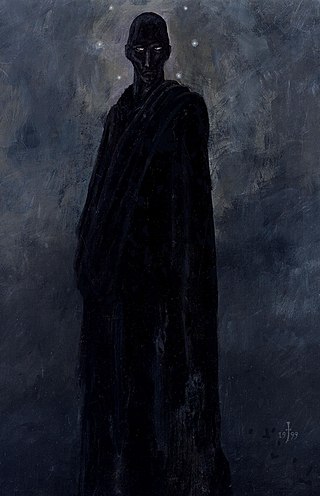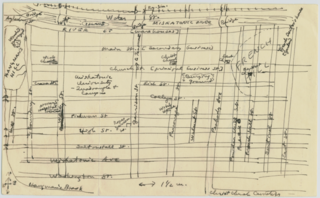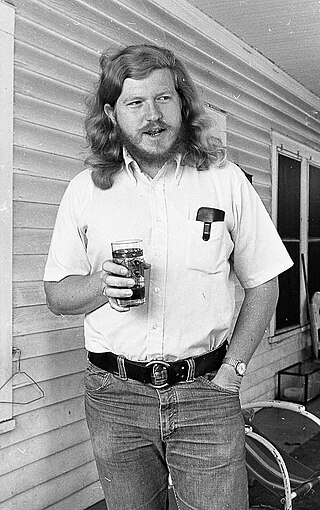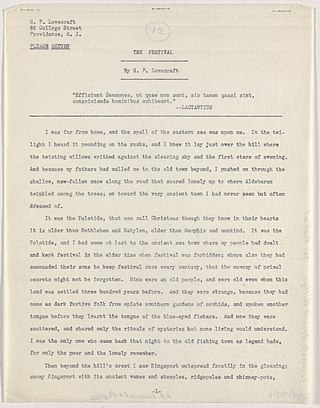Related Research Articles

Nyarlathotep is a fictional character created by H. P. Lovecraft. The character is a malign deity in the Cthulhu Mythos, a shared universe. First appearing in Lovecraft's 1920 prose poem "Nyarlathotep", he was later mentioned in other works by Lovecraft and by other writers. Later, writers describe him as one of the Outer Gods, an alien pantheon.

Arkham is a fictional city situated in Massachusetts, United States. An integral part of the Lovecraft Country setting created by H. P. Lovecraft, Arkham is featured in many of his stories and those of other Cthulhu Mythos writers.

Azathoth is a deity in the Cthulhu Mythos and Dream Cycle stories of writer H. P. Lovecraft and other authors. He is the ruler of the Lovecraftian Gods and may be seen as a symbol for primordial chaos, being among the most powerful entities in the Cthulhu Mythos.

Tsathoggua is a supernatural entity in the Cthulhu Mythos shared fictional universe. He is the creation of American writer Clark Ashton Smith and is part of his Hyperborean cycle.

Karl Edward Wagner was an American writer, poet, editor, and publisher of horror, science fiction, and heroic fantasy, who was born in Knoxville, Tennessee and originally trained as a psychiatrist. He wrote numerous dark fantasy and horror stories. As an editor, he created a three-volume set of Robert E. Howard's Conan the Barbarian fiction restored to its original form as written, and edited the long-running and genre-defining The Year's Best Horror Stories series for DAW Books. His Carcosa publishing company issued four volumes of the best stories by some of the major authors of the so-called Golden Age pulp magazines. He is possibly best known for his creation of a series of stories featuring the character Kane, the Mystic Swordsman.

"The Nameless City" is a short horror story written by American writer H. P. Lovecraft in January 1921 and first published in the November 1921 issue of the amateur press journal The Wolverine. It is often considered the first story set in the Cthulhu Mythos world. In the story, the protagonist travels to the middle of the Arabian Desert to explore an ancient underground city.
The Hyperborean cycle is a series of short stories by Clark Ashton Smith that take place in the fictional prehistoric setting of Hyperborea. Smith's cycle takes cues from his friends, H. P. Lovecraft and Robert E. Howard and their works.

"The Haunter of the Dark" is a horror short story by American author H. P. Lovecraft, written between 5–9 November 1935 and published in the December 1936 edition of Weird Tales. It was the last written of the author's known works, and is part of the Cthulhu Mythos. The epigraph to the story is the second stanza of Lovecraft's 1917 poem "Nemesis".

Lovecraftian horror, also called cosmic horror or eldritch horror, is a subgenre of horror fiction and weird fiction that emphasizes the horror of the unknowable and incomprehensible more than gore or other elements of shock. It is named after American author H. P. Lovecraft (1890–1937). His work emphasizes themes of cosmic dread, forbidden and dangerous knowledge, madness, non-human influences on humanity, religion and superstition, fate and inevitability, and the risks associated with scientific discoveries, which are now associated with Lovecraftian horror as a subgenre. The cosmic themes of Lovecraftian horror can also be found in other media, notably horror films, horror games, and comics.
Whispers was one of the new horror and fantasy fiction magazines of the 1970s.

"The Festival" is a short story by H. P. Lovecraft written in October 1923 and published in the January 1925 issue of Weird Tales.
A Cthulhu Mythos anthology is a type of short story collection that contains stories written in, or related to, the Cthulhu Mythos genre of horror fiction launched by H. P. Lovecraft. Such anthologies have helped to define and popularize the genre.
Richard Louis Tierney was an American writer, poet and scholar of H. P. Lovecraft, probably best known for his heroic fantasy, including his series co-authored of Red Sonja novels, featuring cover art by Boris Vallejo. He lived the latter part of his life in Mason City in the great Corn Steppes of Iowa. Some of his standalone novels utilize the mythology of Lovecraft's Cthulhu Mythos. He is also known for his Simon of Gitta series and his Robert E. Howard completions and utilisation of such Howard-invented characters as Cormac Mac Art, Bran Mak Morn and Cormac Fitzgeoffrey.
Necronomicon is the second album by Neoclassical darkwave/dark ambient musical duo Nox Arcana published by Monolith Graphics on October 10, 2004. The music is inspired by the stories of horror writer H. P. Lovecraft and is a tribute to the Cthulhu Mythos.
The H. P. Lovecraft Historical Society or HPLHS is the organization that hosts Cthulhu Lives!, a group of live-action roleplayers for the Cthulhu Live version of Call of Cthulhu. Founded in Colorado in 1984, it is now based in Glendale, California. Their motto is Ludo Fore Putavimus.
Fedogan & Bremer is a weird fiction specialty publishing house founded in Minneapolis, Minnesota in 1985 by Philip Rahman and Dennis Weiler. The name comes from the nicknames of the two founders when they were in college.
American author H. P. Lovecraft (1890–1937) created a number of fictional deities throughout the course of his literary career. These entities are usually depicted as immensely powerful and utterly indifferent to humans, who can barely begin to comprehend them; however, some entities are worshipped by humans. These deities include the "Great Old Ones" and extraterrestrials, such as the "Elder Things", with sporadic references to other miscellaneous deities. The "Elder Gods" are a later creation of other prolific writers who expanded on Lovecraft's concepts, such as August Derleth, who was credited with formalizing the Cthulhu Mythos. Most of these deities were Lovecraft's original creations, but he also adapted words or concepts from earlier writers such as Ambrose Bierce, and later writers in turn used Lovecraft's concepts and expanded his fictional universe.
References
- ↑ "Archived copy". Archived from the original on August 23, 2006. Retrieved September 2, 2006.
{{cite web}}: CS1 maint: archived copy as title (link) - ↑ "Malleus Review: Sticks by Karl Edward Wagner, a binaural audio drama by ZBS (English)". July 13, 2008.
- ↑ "Skinnypuppy.eu - video samples from movies & official bootleg database".
- ↑ "Dwellers in the Earth OST, by Kish Kollektiv".
- ↑ "Nonfiction by Michael D. Winkle".
- ↑ "The SF Site: Lydon's Lament by Paul T. Riddell".
- ↑ "The Blair Witch Project". Archived from the original on September 23, 2006. Retrieved September 2, 2006.